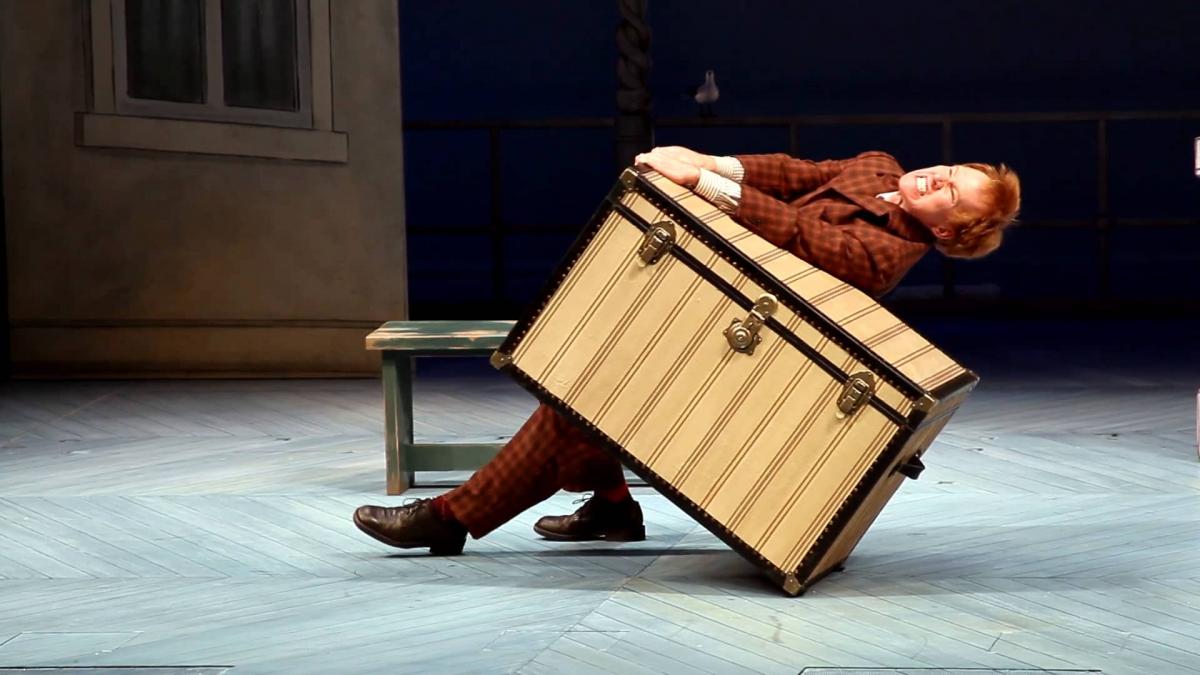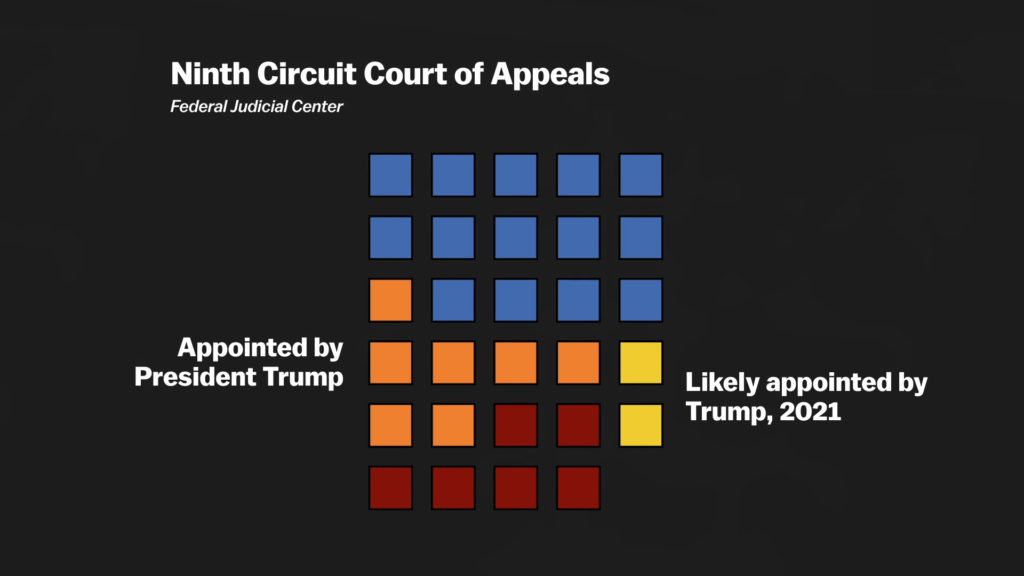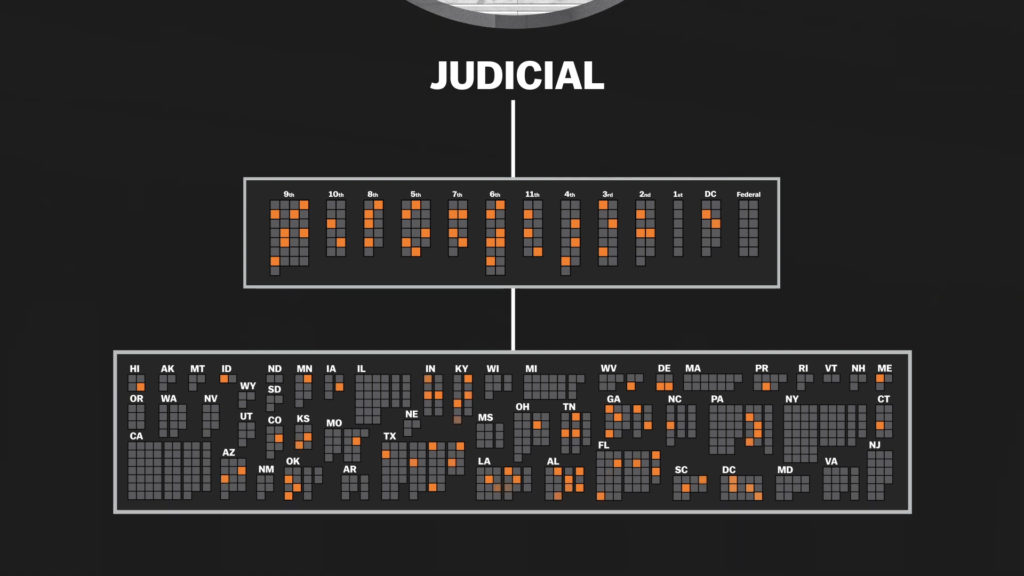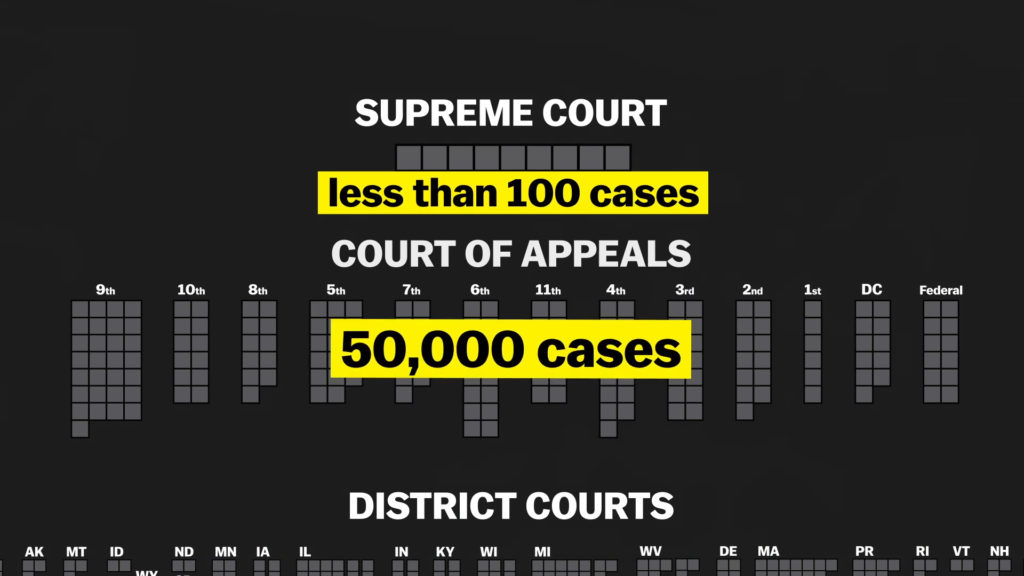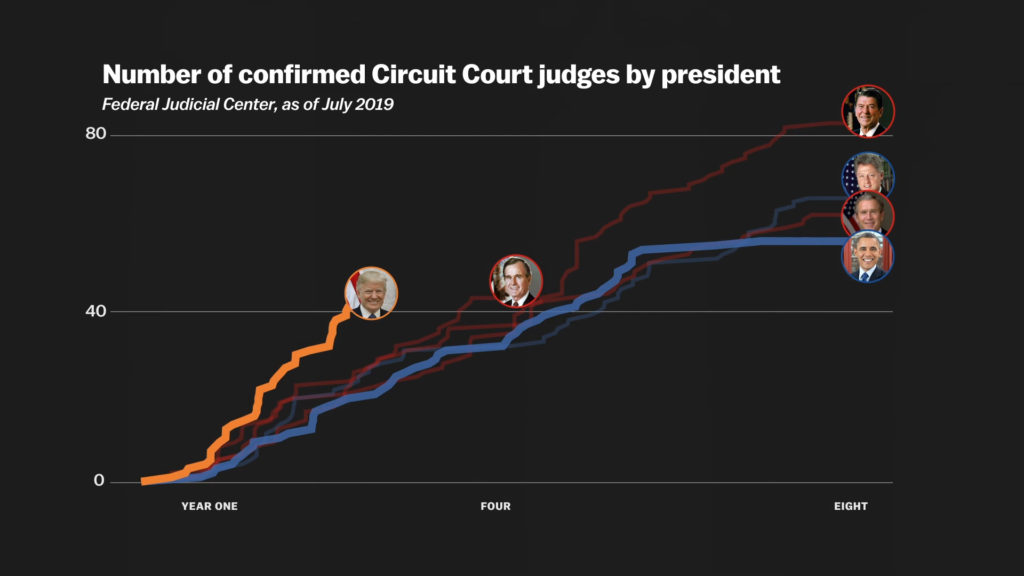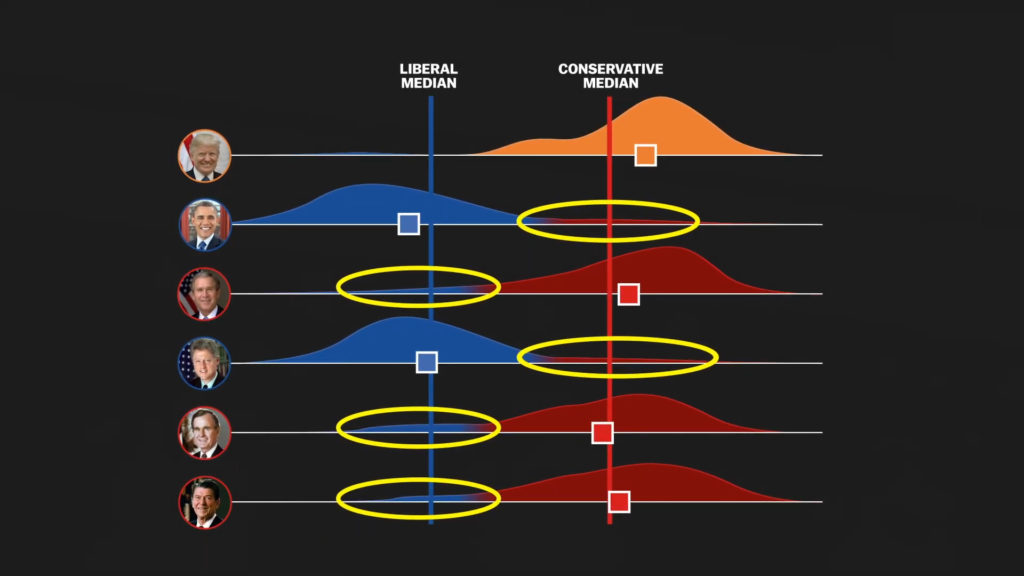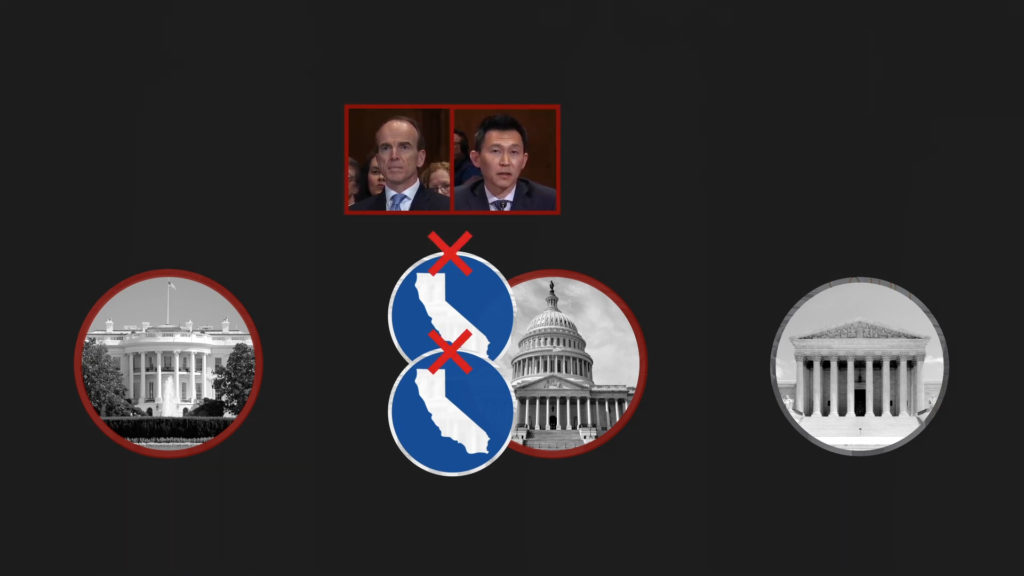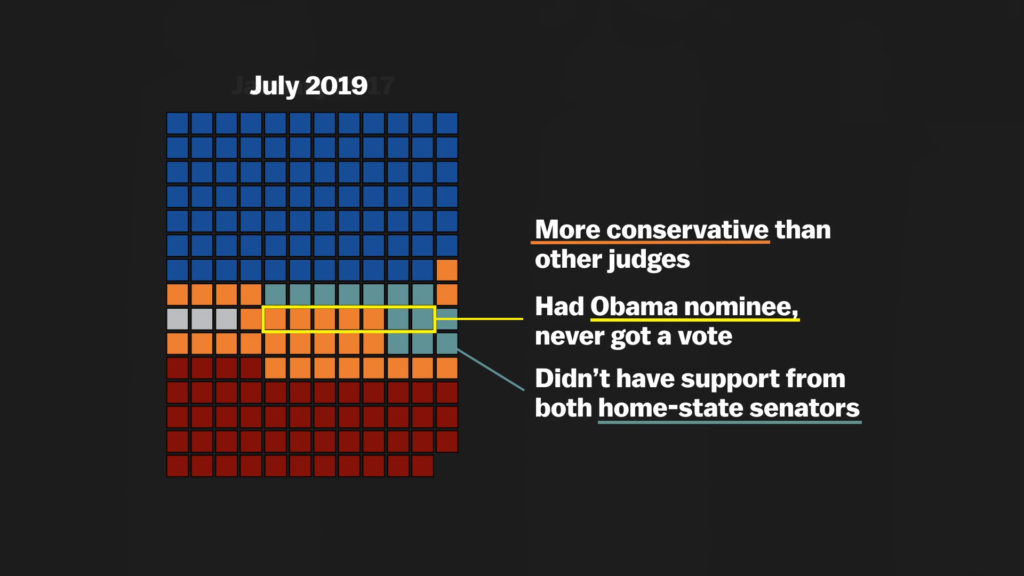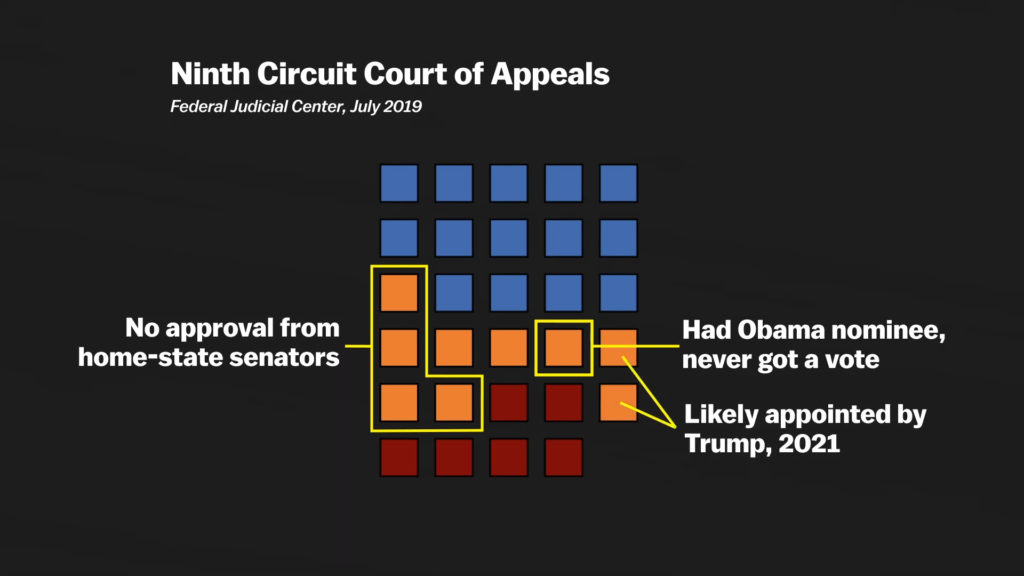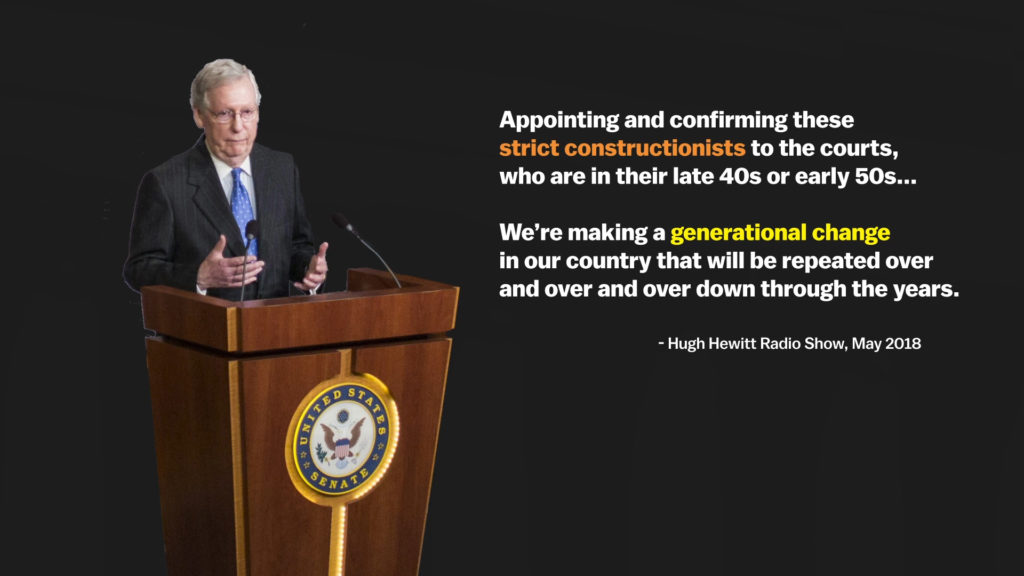With the nomination of Amy Coney Barrett, the Republicans are hanging the pistol.
(with an enormous hat tip and thanks to my researchers Chloe Demos and Alexandra Dumont)
12 October 2020 (Crete, Greece) – A few weeks ago I watched Donald Trump announce he was nominating Amy Coney Barrett to replace Ruth Bader Ginsburg on the Supreme Court. Many wonder where we’d be today if at that lunch in 2013 Ginsburg took up Obama’s hint to retire.
But, alas, here we be. Barrett’s Senate confirmation hearing began today. She was born in 1972 so, as many have noted, we can expect she’ll spend several decades shaping both American law and American life. I heard she was a popular professor at Notre Dame Law School, which she also attended and from which she graduated summa cum laude, and then clerked on the Supreme Court for Justice Scalia. As a judge on the Seventh Circuit, media reports say she has been a reliable conservative voice. Even liberal peers in the judicial academy find her personable. I have no doubt she’ll do well in providing the artful non-answers that are the currency of Supreme Court confirmation hearings before the Senate Judiciary Committee.
FUN NOTE: Amy Coney Barrett’s seat came up on the 7th Circuit February 18, 2015 when Judge John Tinder stepped down. As McConnell had already put up the Red Wall in 2010 (more on that below), McConnell made sure the seat sat empty for two years, with Senate Republicans stonewalling Obama’s pick Myra Selby. When Trump became president in 2017, the Republican senate quickly confirmed Barrett on Halloween 2017 (by a 55-43 count).
And I cannot be the only one who saw the Barrett announcement was like when the Nazis opened up the Arc of the Covenant in Raiders of the Lost Arc. Amy brought her 7 unmasked kids to a COVID-19 super spreader event to show how pro-life she is so she could be confirmed by a group of pro-life people who have presided over 250K+ deaths to be a pro-life judge that will uphold the death penalty and probably take away Americans’ health insurance.
Oh, and the U.S. political press certainly hasn’t lost its ability to either manufacture a story or bite into a political party’s talking points. Former Attorney General Eric Holder said “the Democrats should pack the Court” and right on cue the media pounces with “Will Biden pack the courts” stories – the new “Hillary’s emails” for 2020. It’s a way for journalists and others to demonstrate a false “balance” by wildly overweighting a small qualm on one side so that it appears as significant as huge scandals on the other. But when it comes to the Supreme Court, the balance of media attention between something Democrats could possibly, maybe do one day if ten different things line up versus something Republicans are doing right seems a bit off. To be clear: conservatives are complaining that Joe Biden won’t take a position on changing the size of the Supreme Court – which has not happened since 1869 – but it’s ok for Trump to vacillate about a peaceful transition of power? Yeah, that makes a lot of sense. More in my postscript at the end of this post.
But that’s America. And hell: after last week’s report by the U.S. House Judiciary Committee on the monopoly power and practices of the world’s largest technology companies (or what I like to call the Congressional interns’ report “what-I-did-over-summer-vacation-Googling-every-bad-thing-I-could-find-about-technology”) what can you expect from a sclerotic, dysfunctional and corrupt mess of a political system.
But just because the court is a thoroughly American institution, that doesn’t mean its impact stops at U.S. borders. Its decisions affect foreign citizens, and the political wrangling over its future will resonate globally for years. Justice Ginsburg was a globally significant jurist. Her story and the Court’s story captivated people in the legal profession around the world. And decisions made by the Supreme Court can have significant practical impact abroad, especially when they involve commercial or administrative law. They can also affect people outside U.S. borders even when rulings come down to interpretations of the U.S. Constitution.
Note for my UK readers. If you read the UK press there is a shaking of heads and a cry of “things are done differently here, for the appointment of judges is not politicised”. Well, according to a recently retired UK judge who has been a long-time friend, not so. It’s just that the British are rather good at pretending otherwise: “The notion that there has been some total structural divide between politicians and judges in England betrays a lack of knowledge of the country’s legal history. Even now, barristers (the lawyers who tend to present cases in court) are encouraged to provide regular legal services to ministers and officials at a substantial discount so as to obtain promotion to the judiciary by joining a prestigious panel. The best of them are given income streams as ‘Treasury counsel’, charged with helping the government out of awkward or sensitive political-legal situations; in return they are often appointed as a High Court judge. In this way judicial preferment is formally based in part on assisting ministers and officials. And when appointed, judges are often in effect lawmakers and policymakers, though they cloak it as ‘developing’ existing law.”
I am sure none of this is necessarily wrong; much of it is a normal fact of political and legal life. Judges with political worldliness are not a bad thing. But on both sides of the Atlantic it is a simplistic and misleading notion that law and politics are completely separate public realms. It’s just that in the U.S. it slaps you right in the face.
Americans have enough divisive matters to worry about – not least a potentially bitter, violent, contested presidential election – without being driven crazy over a Supreme Court appointment. But they will be driven crazy. That’s just American society and politics. But let’s try to unpack some of the long-term, big issues over this nomination, and detail what I think are the fears of the Trump Resistance.
The appointment to replace the late Justice Ruth Bader Ginsburg is certainly important. And it’s easy to understand why most Americans think the choice should be made by whoever is elected in November, especially given what happened – or did not happen – with President Barack Obama’s nomination of Merrick Garland in 2016. I understand the concern that confirming Judge Amy Coney Barrett could “transform the court for a generation.”
But Justices come and go, and the balance of power on the Supreme Court shifts back and forth. It seldom stays the same for long. Ginsburg was the most left-progressive member of the court, close to Justice Sonia Sotomayor but certainly more liberal than Justices Stephen G. Breyer and Elena Kagan. Any Republican president’s appointee, however moderate, would therefore move the court toward the center or the right.
If you have the time, I recommend two foundational texts for an overall history of the Court: “A People’s History of the Supreme Court” by Peter Irons and “Supreme Conflict” by Jan Crawford Greenburg. Yes, there are 100s of books about the history and politics of the Court but I found these two are excellent for a “Here-is-the-Big-Picture-of-the-Supreme-Court” view.
And speaking of “Big Picture” the Democrats are not primarily focused on Barrett, although they say they are. They are looking far longer term. The three oldest justices, and therefore the three most likely to leave the court in the coming years, are Breyer (82), Samuel Alito (70) and Clarence Thomas (72). Breyer is the most moderate of the Democratic appointees. Replacing him with a progressive Democrat would be like replacing Justice Sandra Day O’Connor with Alito (as happened in 2006). Thomas and Alito are the most conservative members of the court. Assuming Biden is elected next month, the court could easily be dominated by its left wing again, in just a few years, even with Barrett on the bench. This is certainly not a reason for Barrett’s opponents to relax and support her, but it is a reason for everyone to calm down just a wee bit. Plus, most of the damage to the U.S. judicial system has been done. See below as I continue.
And as Laurence Tribe, the noted American constitutional law scholar, has said (and I’ll have more from him further in this post) even the current court, with a solid majority of five conservative-seeming justices, has decided many of the most important cases over the past year in favor of the liberal position. Consider Bostock (interpreting Title VII to apply to same-sex and transgender discrimination), Regents (striking down Trump’s revocation of Deferred Action for Childhood Arrivals, or DACA) and Vance (allowing the New York district attorney to subpoena Trump’s financial records). This is because modern conservative legal theory is primarily about methodology rather than results.
But overall Tribe views the Barrett nomination very negatively which I will detail below.
What about abortion rights? Well, in confirmation battles going back to the 1980s, abortion rights advocates have predicted that every nominee by a Republican president, if confirmed, would mean the reversal of Roe v. Wade. Yet it has never happened. Republican presidents have filled nine seats since Ronald Reagan was elected president; nine times the nation was warned that Roe was on the chopping block. Somehow, the blade never falls. Roe was reaffirmed this summer, in effect, by June Medical, with a majority opinion written by Chief Justice Roberts Jr., an appointee of President George W. Bush.
Roe is the Road Runner of all precedents. Wile E. Coyote just never catches up.
But I go back and forth on this one. There are reasons Roe is so resilient — and one of them is not the legal persuasiveness of the opinion, which is nil. But the ruling is nearly a half-century old and has been reaffirmed multiple times by justices of both parties. Such a decision will not be lightly overruled. And whatever one may think of abortion, the practice is so widespread and ingrained, and the right to it so intensely defended by a significant minority of Americans, that trying to use the force of the state to end it would wrench the nation apart — while almost surely failing.
I’ve also read some of the conservative blogs like that of Michael McConnell, now a professor of law and director of the Constitutional Law Center at Stanford Law School but formerly a judge on the U.S. Court of Appeals for the 10th Circuit who had a very conservative pitch to his decisions. A few weeks ago he noted on his blog:
The politics of Roe would not be kind to pro-lifers. Right now, abortion-related disputes concern very marginal cases (such as late-term abortions, parental consent, sex-selective abortion and disposal of fetal remains) where public opinion is divided and the majority might even support increased restrictions. If Roe were overruled, the debate would shift to out-and-out prohibitions, where public opinion is squarely on the side of abortion rights. Republican Party primaries would feature fights to the death between purists and compromisers, and a united pro-choice Democratic Party would gain the advantage.
The notion that a Barrett appointment will mean the invalidation of the Affordable Care Act is even more far-fetched. True, a case seeking the ACA’s end has reached the Supreme Court and will be decided in the coming term. But most legal observers — even conservatives with no affection for Obamacare — think the legal basis for the challenge is laughably weak, and wonder if even one justice (let alone five) will buy it.
Eh …. no. After due consideration, I see major issues. Let’s unpack that a bit. The Barrett nomination does matter. A Justice Barrett is unlikely to lead the court in more progressive directions, and more likely to read statutes and the Constitution to mean what they say, and not what liberals want them to say. And those abortion “marginal cases” (late-term abortions, parental consent, sex-selective abortion and disposal of fetal remains) McConnell noted above could be used to simply chip, chip, chip away at Roe so it is never formally “overturned” but simply gutted, much as the Court has tried to do with Obama Care and the Voting Rights Act (see my comments on Shelby below).
And for more on the negative side, a few points:
Barrett is a card-carrying member of the Federalist Society. Her financial-disclosure form shows that, in recent years, she has received about seven thousand dollars in honoraria from the Federalist Society and went on ten trips funded by it. Under Republican Presidents, Federalist Society events have come to operate as auditions for judicial appointments. The corporate interests funding the growth of the Federalist Society are focused on crippling the regulatory state. And conjoined with Mitch McConnell, the Senate Majority Leader, it also promotes the deregulation of political campaigns, a passion of Mitch of decades.
NOTE: the Federalist Society was gestated in 1971, the “child” as it were of Lewis Powell, Jr., then a prominent lawyer in Richmond, Virginia, and later a Supreme Court Justice himself. He wrote the now famous memorandum to the United States Chamber of Commerce that argued businesses needed to take a more aggressive hand in shaping public policy, that business interests should make a major financial commitment to shaping universities, so that the “bright young men” of tomorrow would hear messages of support for the free-enterprise system. A little less than a decade later, a pair of law professors named Robert Bork and Antonin Scalia signed on to be the first faculty advisers to a fledgling organization for conservative law students called the Federalist Society for Law and Public Policy Studies. Corporate sponsorships poured in.
But the worst I have read about Barrett has been her self-description as a “textualist” and an “originalist” – the same words of legal jargon that were associated with Scalia. She believes in relying on the specific meaning of the words in statutes, not on legislators’ intent. She interprets the Constitution according to her belief in what the words meant when the document was ratified, not what the words mean now.
These words are abstractions. In the real world, they operate as an agenda to crush labor unions, curtail environmental regulation, constrain the voting rights of minorities, limit government support for health care, and free the wealthy to buy political influence. And in the U.S., unless you’ve been living under a rock for the last 40+ years and have ignored U.S. history, that is exactly what has happened to America. It has for quite some time become a developing country disguised by the strength of its economy. Anyone surprised by the terrible impact of the pandemic, the chaotic response and general ignorance and unpreparedness simply hasn’t been paying attention.
Extreme income inequality and lack of universal healthcare and worker protections have created this sick economic superpower where being rich is all that matters, and most citizens live in poverty. I have seen poor parts of the US that remind me of the favelas in Brazil. Everything seems to be fake, bombastic and artificial in the US, so it is no wonder its citizens can no longer tell the difference between truth and false. The mental bandwidth of many people can span only as far as the next quick fix.
It should go without saying that the nomination and the expected confirmation of Barrett in the final days before a Presidential election represent a paramount act of hypocrisy for McConnell and the other Republicans who denied even a hearing to Merrick Garland. But the fact that these Republicans are willing to risk that charge shows how important the Supreme Court is to them. They believe a Supreme Court Justice like Barrett can deliver on their agenda.
The Trump Resistance: a suitcase without a handle
When I made my first trip to Ukraine over 6 years ago as part of my information war/cyber war education, I tried to learn some Russian and Ukrainian. One phrase that stuck with me was “чемодан без ручки” (“suitcase without a handle”) – meaning something too important not to keep carrying but too difficult to carry for any distance. I think it describes perfectly what the Democrats and the Trump resistance movement faces.
I pity the Trump Resistance. Yes, there is a Constitution. But after decades of political gridlock, electoral corruption, and dysfunction in the U.S. system of “government” scholars, activists, and citizens question the document’s ability to address the thorniest issues of modern political life. The U.S. is the poster child for stalemate, minority rule, and executive abuse.
Because the Resistance is battling an entrenched kakistocracy. Republicans play hardball and are gleefully remaking the judiciary for an entire generation, maybe two generations. Democrats have brought knives to a gun fight. They still don’t know what they’re up against. They do not understand the incredible power of modern propaganda coupled with tribalism. Look how many people … mostly the Republican base … believe there are “insidious forces” working against them. The U.S. is losing its judiciary because none of the checks are holding. Well, the “checks” are actually voluntary. The Trumpeteers know they can be ignored and there will be no accountability.
James Madison (principal architect of the Constitution) even warned about it, trying to design a government that would resist mob rule — but they did not/could not anticipate how strong the mob could become. Over the lockdown I reread The Federalist Papers and one series from Madison jumped out at me. He was referring to impetuous mobs as factions and said:
how do we guard against factions in government, united and actuated by some common impulse of passion, or of interest, adversed to the rights of other citizens, or to the permanent and aggregate interests of the community. Factions arise when public opinion forms and spreads quickly and can only dissolve if the public is given time and space to consider long-term interests rather than short-term gratification.
Madison also did not figure on all of the branches of the government forming as one mob, enabling each other as they wished. It is why I wrote last year that writers like Sarah Kendzior and Andrea Chalupa had it right all the time. The Mueller Report would be a “nothing burger”. Trump would not be stopped. His enablers and sycophants would make sure of that. There was a fundamental mismatch. Trump and his lawyers were cutting every corner, trampling on every ethical guideline, while Mueller and those like him (and later on the House of Representatives lawyers during the impeachment) were primly weighing up the legal niceties and nuances. They were thumbing through the rulebook of the monastery while in front of them a mafia don set the monastery on fire.
And as for the U.S. judicial system, Kendzior and Andrea Chalupa were right again. Trump had his “rules”. That system that legal scholars had in place … rule of law, traditional norms and constitutional strictures … were all “voluntary”. The Republicans and Trumpeteers wanted a most solid ally: a 3rd legislative branch, formally known as the U.S. Supreme Court.
“Yee, ha! I got 200 judges confirmed! A legislative record!”
Laurence Tribe, the noted American constitutional law scholar (I think many of the U.S. lawyers reading this post were assigned at least one of his texts in law school) noted in a string of Tweets over the last two weeks that most Federal judicial opinions are grounded in the applicable Federal statute more so than the U.S. Constitution. Yes, the Constitution is the underlying source of law, but it’s not like every case “consult” or quotes the Constitution. And … normally … the judges don’t perceive things “in light of 21st century issues”. Ideally they stick to the text of the relevant statute or precedent. Courts are not and should not be policy makers. It’s the legislature that should be looking through a 21 Century lens.
But, he says, that is slowly changing, as the U.S. Supreme Court has been whittling away a great part of the authority presumably given the government for protection of civil rights. In past Tweets he has pointed to the Court’s decision in Shelby County v. Holder which most legal journalists commonly say “gutted” the Voting Rights Act although Tribe says the more appropriate terminology might be to say that it “defanged” federal enforcement of that act. But his point was clear: the Court was legislating. Following the Shelby County v. Holder decision the Court has taken on additional voting-rights cases, and furthered Roberts’s mandate to distance the federal judiciary from Thurgood Marshall’s vision of those bodies as active watchdogs for the Fourteenth and arbiters for America’s racial injustices.
NOTE: I think Shelby County v. Holder broke America’s back. Justice Ruth Bader Ginsburg summarized her dissent, from the bench, an unusual move and a sign of deep disagreement. She cited the words of the Rev. Dr. Martin Luther King Jr. and said his legacy and the nation’s commitment to justice had been “disserved by today’s decision”. The decision in Shelby County opened the floodgates to laws restricting voting throughout the United States. The effects were immediate. Within 24 hours of the ruling, Texas announced that it would implement a strict photo ID law. Two other states, Mississippi and Alabama, also began to enforce photo ID laws that had previously been barred because of federal preclearance.
Roberts’s legal analysis boils down to the fact that preclearance was very effective in reversing disenfranchisement, so the country no longer needs it. In her dissent, Justice Ruth Bader Ginsburg pointed out the apparent paradox of that reasoning, writing that “throwing out preclearance when it has worked and is continuing to work to stop discriminatory changes is like throwing away your umbrella in a rainstorm because you are not getting wet.”
I also think that America’s uniquely litigious culture adds to this. You’ve seen the commercials:
“If you or someone you know has been harmed by X, call our legal firm right now! You may be entitled to compensation.”
X could be anything from asbestos, to bad breath (kidding). This mass recruitment of victims, both real and imagined, is a key weapon deployed by the activist-legal complex in its attempt to shake down companies for money. In U.S. politics, as in the rest of all life in the U.S., everyone wants to escalate the dispute: “I want to speak to your manager!” or “I’ve been wronged and I’m going to make this into a constitutional litigation!” Right? And so everybody goes to the courts, to make their “constitutional argument”. It’s what Rosa Brooks calls “constitutional creep”. U.S. political scientists talk about the “judicialization of society”, or the “constitutionalization of society”, where given a dysfunctional and corrupt mess of a legislative system things get pushed into the legal and constitutional arenas, because there is no other place to go.
For a very illuminating read on this subject I recommend a 1970 book by Albert Hirschman, Exit, Voice and Loyalty. Hirschman, an economic theorist, offers a brilliantly simple analysis of what options are available to us when we are being let down: we either go elsewhere or we complain. These options (“exit” and “voice”) are central in organisational theory, especially in corporate governance, where the balance between exit (withdrawal of capital) and voice (voting, board membership) is fundamental. For Americans, he says, “voice” will always rule.
For Trump, what doesn’t kill you makes you stronger
Trump and his lawyers know “the law is an ass” (nobody had a better feel for the hypocrisy of the law than Charles Dickens) and they know Trump has survived via a swarm of lawyers constantly doing his bidding in any court they can find. Trying to get the courts to be legislators.
But it is his power over the U.S. judicial system that will be his lasting legacy.
When Trump took office, most of the Ninth Circuit’s judges had been appointed by Democratic Presidents, and they overruled some of Trump’s most provocative executive orders. The travel ban, emergency funding for a border wall … they all stopped there. Trump has slowly put new judges in the Ninth Circuit. Trump has already added seven new judges and by the end of his first term the Ninth Circuit will look very different.
We usually think of the three branches of government as the President, Congress and the Supreme Court. But it’s down there, in the lower federal courts, where Trump is building his longest lasting legacy.
As Trump said: “You know, when I got in, we had over 100 federal judges that were un-appointed. It was like a big, beautiful present to all of us”.
Why is this important? Federal courts hear lawsuits involving the Constitution or laws made by Congress. Say a city pays a female employee less than her male counterpart, that violates the Equal Pay Act, a federal law. So that case would start there, where all federal lawsuits start, in a District Court. There’s at least one in every state. For example, California is home to 61 judges, who serve on the state’s four district courts. If the case is appealed, it moves up to the aptly named Court of Appeals. It’s made up of 13 Circuit Courts and they each hear cases from different parts of the country. So a case that started in California will move up to the Ninth Circuit Court because they hear cases from the western part of the U.S. If it’s appealed again, it’ll go to the Supreme Court. But the Supreme Court hears less than 100 cases a year.
But the Circuit Courts, they hear 50,000. For most federal cases, these judges give the final precedent setting ruling.
So this is a huge factor. Every single judge here is nominated by the President and serves for life.
Now here’s a chart showing how many Circuit Court judges a President confirmed by what time in their presidency. There’s Ronald Reagan, George H. W. Bush, Bill Clinton and George W. Bush. All pretty consistent, yes? Now look at Barack Obama’s. Look how it totally flat lines in his last two years.
That’s because all federal judges are nominated by the President but then have to be confirmed by a vote in the Senate. And after the 2014 elections, Republicans gained control in the Senate and Mitch McConnell stopped holding votes on nearly all of Obama’s court picks, from the Supreme Court all the way down to the District Courts.
So when Trump took office, not only did he have a ton of vacancies to fill, he had a Republican controlled Senate to help fill them, quickly. In fact, Trump has appointed more Circuit Court Judges in the first half of his first term than any other modern President.
But his judges are different. The chart shows where all the judges nominated by each President fall on a scale between Liberal and Conservative, determined by their past political donations. And there’s the median score for those judges. You can see that appointees on both sides have moved further to the left and right of their parties’ medians. But Trump’s median pick is more Conservative than Obama’s was Liberal, and more Conservative than his Republican predecessors. And if you look at the ideological distribution of judges appointed by previous Presidents, you can see tails at either end.
Both Republican and Democratic Presidents appointed some judges that leaned the other way. But Trump, not really.
Traditionally, Presidents need to work with the Senate. If a judgeship opens up in, say, Texas, the nominee would need the approval of the Texas Senators. No approval, no vote. It makes Presidents compromise with the opposite party and prevents them from stacking the courts with super partisan judges. That’s why these past Presidents had to have a spectrum of judges.
But when Trump nominated two men for seats on the Ninth Circuit, the court that keeps overturning Trump’s Executive Orders, the two Democratic Senators from California opposed both of them, calling them, “Far outside the judicial mainstream.” One because of some controversial writings in college and the other because of his prior work as a defense lawyer, including for oil companies, where he argued climate change isn’t real.
Normally, this would mean they would never get a vote, let alone a hearing, but Republicans did not honor the century old informal rule. And judges were being confirmed without the support of either home state Senator, including those two on the Ninth. Trump has now appointed eight new judges to the Ninth Circuit, one because Obama’s nominee wasn’t allowed a vote, and four without the approval of home state Senators.
A set of graphs to show what the Circuit Courts looked like when Trump became President at the beginning of 2017, and how the court looked halfway through 2019.
It’s expected that every President gets to have an impact on the federal courts. That’s normal, but Trump only got to fill these seats because of McConnell’s refusal to hold a vote on Obama’s picks. None of these Trump picks had the support of both Senators from their home state and, as a group, Trump’s picks are more Conservative than his Republican predecessors.
In 2018, Mitch McConnell laid out his goals for the federal judiciary in a radio interview:
NOTE: we had intended to update the graphs above to reflect additional judges confirmed through last summer but I wanted to get this post out today and we have another large project about to distribute. The key point is that McConnell’s plan worked. Over the summer he reached a significant milestone by filling the final vacancy on the U.S. Circuit Court of Appeals, an achievement that fulfills his goal of remaking the federal judiciary as more conservative for a generation but also one that is less diverse. There is not a single Circuit Court vacancy anywhere in the nation for the first time in at least 40 years. And that is important because the Circuit Courts are often the prime breeding ground for Supreme Court justices.
The conservative shift of the court under Trump and McConnell is not just ideological – the federal courts have also become younger, more white and more male. Not one of the 200+ judges confirmed is Black. But for conservatives, the diversity of the judges matters less than their conservative ideology. David McIntosh, a board member of the Federalist Society, are “constitutionalists and very good judges that believe in a limited judiciary.”
The U.S. Supreme Court may be beyond repair
Last year the biggest (predictable) setback was when the court refused (in Rucho v. Common Cause) to take a stand against the extreme partisan gerrymandering that is crucial to the Republican Party’s hold on state and national power. Roberts wrote in that case:
“this presented political questions beyond the reach of the federal courts”
As historian Eric Foner observed in The Nation magazine shortly after the decision was issued:
The idea that the Supreme Court does not have the authority to get involved in political matters would be laughable if the results of this decision were not so damaging. Was not “Baker v. Carr”, the one man-one vote decision of the 1960s, political? What about “Bush v. Gore”, which decided the outcome of a presidential election?
And Justice Elena Kagan noted in her dissent to the Rucho decision that it showed the court “throwing up its hands at a practice that at its most extreme . . . amounts to ‘rigging elections’” … and for the first time the Court stated such issues “were not amenable to judicial redress”.
But that’s the issue, that’s the problem. With a polarized Congress it is nearly impossible to get anything done so that would seem to leave the courts as the logical place for legislative activism, right? Yep, and the Republicans know this. The GOP has control of the U.S. Senate and now has the power to cement the status of the U.S. Supreme Court as a a legislative branch. Plus they control 26 governorships. That could change in November of 2020, but the whole point of the district lines that were drawn after the 2010 census was to make legislative turnover as unlikely as possible and that is key.
The Roberts Court has been consistently helpful to Republican efforts to distort the election system. Roberts led the 5-4 decision in Shelby County v. Holder as noted above. He was also in the 5-4 majority of the Citizens United decision of January, 2010, which ruled that congressional attempts to regulate the influence of Big Money in elections were unconstitutional.
Interesting point made on a few law professor blogs. A court that includes Judge Barrett would thrust Roberts from his spot at the court’s ideological center and empower Trump’s three appointees, including two current justices, Neil Gorsuch and Brett Kavanaugh, said Lee Epstein, a law professor and political scientist at Washington University in St. Louis: “We’d expect the center of power to shift from the chief justice to Justices Kavanaugh, Gorsuch and Barrett, effectively transforming the Roberts court into the Trump court”. The new term may include “far fewer blockbusters and far fewer unexpected results” than the last one, said Irv Gornstein, the executive director of Georgetown Law’s Supreme Court Institute. But lurking in the background is the possibility that this could become the most tumultuous and divisive term since the Supreme Court decided “Bush v. Gore” 20 years ago and effectively determined who would be president of the United States.
The logic of the Roberts court in these instances is to say that certain breakdowns in democratic fairness (which are in Kagan’s words “the devaluation of one citizen’s vote as compared to others,” i.e., a violation of the Fourteenth Amendment’s Equal Protection clause) can only be corrected by the political process – while the process remains stacked against efforts to correct them. The court declines to find a way to make an available fix to the fundamental workings of the democratic system.
All of which raises a related question: Can the political system find a way to fix the Supreme Court?
My answer: I do not think so.
The U.S. is stuck now with a court that is the result of specific episodes of democratic failure and thus is of dubious legitimacy in imposing 5-4 decisions on the country. George W. Bush lost the popular vote, benefited from Bush v. Gore, and was able to put two conservatives on the High Court, not to mention more than three hundred federal judges. Trump lost the popular vote and benefited from McConnell’s unprecedented partisan obstruction, and has already been able to appoint Gorsuch, as well as the ill-tempered “what goes around comes around” Brett Kavanaugh, and now Amy Coney Barrett just needs to wait a few days before her confirmation vote.
And the Federalist Society’ role in all of this is paramount. Lots to say about their incredible influence on the U.S. judicial system. For an excellent piece click here.
This Court is poised to shape American society in Trump’s image for decades to come. For now, all three branches of the federal government are committed to the Trump agenda: the restoration of America’s traditional racial, religious, and gender hierarchies; the enrichment of party patrons; the unencumbered pursuit of corporate profit; the impoverishment and disenfranchisement of the rival party’s constituencies; and the protection of the president and his allies from prosecution by any means available.
George Carlin once observed that selfish, ignorant politicians are a direct consequence of selfish, ignorant citizens. His observation was fulfilled on 8 November 2016, and it’s slowly tightening its grip on America’s future (well, maybe all our futures) unless somebody says “ok, let’s cut the crap” and, finally, break the cycle. America is stuck. Let’s see what happens on 3 November.
* * * * * * * * * * * * * *
POSTSCRIPT
Unpacking the media’s chase of a narrative
Or, why we’re talking about a hypothetical when the world is on fire amidst a pandemic
Most of my readers have probably been hearing a lot about “court packing,” where the Democrats are supposedly planning on expanding the number of justices on the Supreme Court should Joe Biden win. The drum beat of court packing has gotten louder and more consistent since progressives started sending up test balloons in 2019, when former Attorney General Eric Holder questioned the validity of the Supreme Court, arguing that:
“Given the Merrick Garland situation, the question of legitimacy is one that I think we should talk about. We should be talking even about expanding the number of people who serve on the Supreme Court, if there is a Democratic president and a Congress that would do that.”
A year later, as Trump’s third nominee starts her confirmation process today, the political press has just slightly overcompensated as court packing was raised by more and more people over the last few weeks. After spending the last four years trying to atone for its failures in the 2016 election, Washington media continues to show that their instincts are often about as solid as … well, jello. That can be the only explanation why, for example, the cable networks and Sunday morning TV shows have administration officials – ones who openly and brazenly lie – on to feed some kind of narrative. The political press is what it is because for decades it has chased the narrative of power, often pushed by the invisible hand of the horse race (who’s up, who’s down, etc) of politics. It serves no one any good.
Court packing. Now the topic du jour because the press keeps asking Biden about this hypothetical that, should he win and should the Democrats flip the Senate and keep the House, he will add more justices to the bench. And because Biden hasn’t responded, the press tries to sink its teeth into this supposed story. That’s a whole lot of “ifs” here for the press to concern themselves about at this particular moment in time, when we’re in the midst of a pandemic. But here’s the thing: the framing of this “court packing” nonsense often misses some important points.
For starters, as Eric Boehlert points out (he has done a boatload of writing on this topic) :
This is all about context. The reason Democrats might be forced to expand the Court is because Republicans are trying to do what’s never been done before in American history — confirm a lifetime appointment to the Supreme Court to a bitterly contested nominee from a wildly unpopular incumbent president while millions of Americans have already voted in the White House contest.
This also gets to the heart of Holder’s argument that the Republicans stole the Democrats’ seat (Garland), but also has shades of another two Supreme Court seats. Recall that the Supreme Court in a 5-4 decision along party lines handed George W. Bush the presidency in 2000, even though he lost the popular vote to Al Gore. Bush went on to get John Roberts and Samuel Alito confirmed.
And now that Trump, who also lost the popular vote to Hillary Clinton, is on the precipice of confirming a third justice, after getting Neil Gorsuch and Brett Kavanaugh through, we have the backdrop.
It would also be good to look at what Republicans said on the eve of the 2016 election, when everyone thought Clinton would win and then nominate a Supreme Court justice. From NPR, a week before the election:
For the first time, some Senate Republicans are saying that if Hillary Clinton is elected, the GOP should prevent anyone she nominates from being confirmed to fill the current court vacancy, or any future vacancy.
Many analysts have argued that the muscle memory of “both sides-ism” journalism, where journalists report on both sides of a story to have the veneer of objectivity, has kicked in. And, in recent days, journalists – with help from Republican operatives – have manufactured a controversy involving Biden. On the trail, Biden is repeatedly asked if he supports expanding the number of justices on the Supreme Court, a policy sometimes referred to as “court packing.” In recent days, Biden has declined to explicitly state whether he would support expanding the court, saying he would “stay focused” on Republican efforts to install Amy Coney Barrett to replace the late Justice Ruth Bader Ginsburg after early voting has already begun. The media has largely accepted the Trump campaign’s argument that Biden’s refusal to definitely answer this question is a scandal.
The most important point, as I outlined above, is that it’s actually been the Republican party who’s filled the bench over the last decade. The story of the Republican Red Wall over the last decade, in one chart:
Boehlert again :
But the press often glosses over what the extreme, unprecedented Barrett nomination process represents. In that report on Harris ‘dodging’ the Court question, CBS News made no mention of the fact that Republicans refused to hold hearings for Garland, while now ramming through the Barrett confirmation. Instead, CBS simply noted, “Mr. Trump and Pence argue the president has a constitutional duty to name a new Supreme Court justice, especially if election-related disputes end up before the court.”
That is my biggest problem with this. Journalism “shouldn’t just be about a news story as an event, but how it’s an intersection of systems and structures and history. Journalists should be accountable for their presentations.
 The Republicans make some adjustments to the U.S. judicial system
The Republicans make some adjustments to the U.S. judicial system


